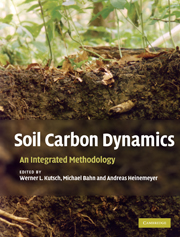Book contents
- Frontmatter
- Contents
- List of Contributors
- Preface
- Editorial Acknowledgements
- 1 Soil carbon relations: an overview
- 2 Field measurements of soil respiration: principles and constraints, potentials and limitations of different methods
- 3 Experimental design: scaling up in time and space, and its statistical considerations
- 4 Determination of soil carbon stocks and changes
- 5 Litter decomposition: concepts, methods and future perspectives
- 6 Characterization of soil organic matter
- 7 Respiration from roots and the mycorrhizosphere
- 8 Separating autotrophic and heterotrophic components of soil respiration: lessons learned from trenching and related root-exclusion experiments
- 9 Measuring soil microbial parameters relevant for soil carbon fluxes
- 10 Trophic interactions and their implications for soil carbon fluxes
- 11 Semi-empirical modelling of the response of soil respiration to environmental factors in laboratory and field conditions
- 12 Modelling soil carbon dynamics
- 13 The role of soils in the Kyoto Protocol
- 14 Synthesis: emerging issues and challenges for an integrated understanding of soil carbon fluxes
- 15 Appendix: Towards a standardized protocol for the measurement of soil CO2 efflux
- Index
- References
2 - Field measurements of soil respiration: principles and constraints, potentials and limitations of different methods
Published online by Cambridge University Press: 11 May 2010
- Frontmatter
- Contents
- List of Contributors
- Preface
- Editorial Acknowledgements
- 1 Soil carbon relations: an overview
- 2 Field measurements of soil respiration: principles and constraints, potentials and limitations of different methods
- 3 Experimental design: scaling up in time and space, and its statistical considerations
- 4 Determination of soil carbon stocks and changes
- 5 Litter decomposition: concepts, methods and future perspectives
- 6 Characterization of soil organic matter
- 7 Respiration from roots and the mycorrhizosphere
- 8 Separating autotrophic and heterotrophic components of soil respiration: lessons learned from trenching and related root-exclusion experiments
- 9 Measuring soil microbial parameters relevant for soil carbon fluxes
- 10 Trophic interactions and their implications for soil carbon fluxes
- 11 Semi-empirical modelling of the response of soil respiration to environmental factors in laboratory and field conditions
- 12 Modelling soil carbon dynamics
- 13 The role of soils in the Kyoto Protocol
- 14 Synthesis: emerging issues and challenges for an integrated understanding of soil carbon fluxes
- 15 Appendix: Towards a standardized protocol for the measurement of soil CO2 efflux
- Index
- References
Summary
INTRODUCTION
Soil respiration is a major component in the carbon balance of terrestrial ecosystems and has been measured in the field for more than eight decades. In this chapter, we will describe the measurement of soil CO2 efflux at the soil surface that can be considered as equivalent to soil CO2 production when integrated over long time periods (week, month or season). At shorter time scales the transport of CO2 may uncouple the soil CO2 efflux from its production inside the soil. Different methods have been developed to measure this efflux. These methods can affect the object being measured by disturbing the biochemical processes involved in CO2 production, the physical properties influencing CO2 movement towards the soil surface, or by changing the environmental conditions in the soil. Therefore, soil respiration measurements in the field are one of the most difficult among the ecosystem flux measurements. So far, no single method has been established as the standard but comparisons, which give important indications on their accuracy, have been performed. The choice of the measurement methodology is not limited to that of a measurement system. The experimenter has to elaborate a protocol depending on the temporal and spatial scales studied. In this chapter, we will describe the most commonly used methodologies for measuring soil CO2 efflux and present their history, principles and constraints (Section 2.2).
- Type
- Chapter
- Information
- Soil Carbon DynamicsAn Integrated Methodology, pp. 16 - 33Publisher: Cambridge University PressPrint publication year: 2010
References
- 13
- Cited by

